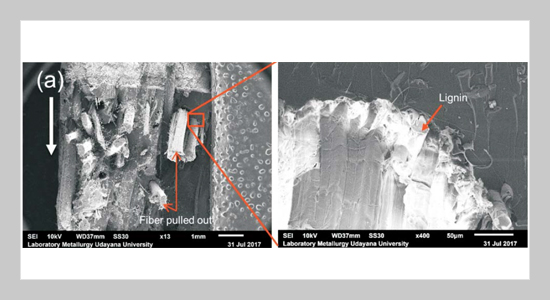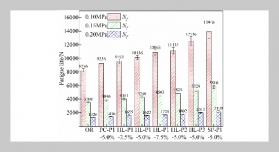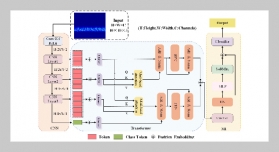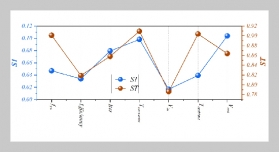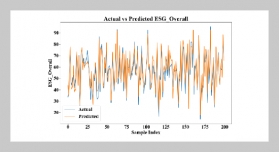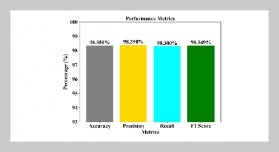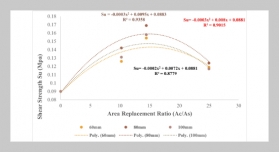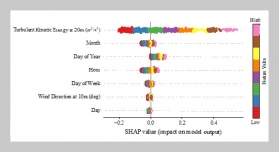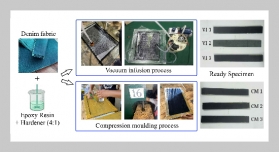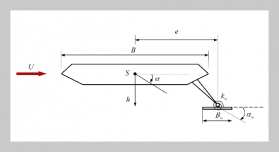REFERENCES
- [1] Jain, S., and R. Kumar. (1994) Processing of bamboo fiber reinforced plastic composites. Mater. Manuf. Processes 9(5), 813-828. doi: 10.1080/10426919408934955
- [2] Das, M., and D. Chakraborty. (2006) Influence of alkali treatment on the fine structure and morphology of bamboo fibers. J. Appl. Polym. Sci. 102, 5050–5056. doi:10.1002/app.25105
- [3] Das, M., and D. Chakraborty. (2009) The Effect of alkalization and fiber loading on the mechanical properties of bamboo fiber composites, Part 1: – Polyester resin matrix. J.
- Appl. Polym. Sci. 112, 489–495. doi: 10.1002/app.29342
- [4] Junior, A. E. C., A. C. H. Barreto, D. S. Rosa, F. J. N. Maia, D. Lomonaco, and S. E. Mazzetto. (2015) Thermal and mechanical properties of biocomposites based on a cashew nut shell liquid matrix reinforced with bamboo fibers. J. Compos. Mater. 49(18), 2203–2215. doi: 10.1177/0021998314545182
- [5] Wong, K. J., B. F. Yousif, and K. O. Low. (2010) Effects of alkali treatment on the interfacial adhesion of bamboo fibres. J. Mater. Des. Appl. 224(3), 139-148. doi:10.1243/14644207JMDA304
- [6] Manalo, A. C., E. Wani, N. A. Zukarnain, W. Karunasena, and K. T. Lau. (2015) Effects of alkali treatment and elevated temperature on the mechanical properties of bamboo fibre-polyester composites. Composites: Part B 80, 73-83. doi: 10.1016/j.compositesb.2015.05.033
- [7] Cai, M., H. Takagi, A. N. Nakagaito, Y. Li, and G. I. N. Waterhouse. (2016) Effect of alkali treatment on interfacial bonding in abaca fiber-reinforced composites. Composites: Part A 90, 589–597. doi: 10.1016/j.compositesa.2016.08.025
- [8] Fang, H., Q. Wu, Y. Hu, Y. Wang, and X. Yan. (2013) Effects of thermal treatment on durability of short bamboo-fibers and its reinforced composites. Fibers and Polymers 14(3), 436-440. doi: 10.1007/s12221-013-0436-5
- [9] Meng, F. D., Y. L. Yu, Y. M. Zhang, W. J. Yu, and J. M. Gao. (2006) Surface chemical composition analysis of heat-treated bamboo. Appl. Surf. Sci. 371, 383–390. doi: 10.1016/j.apsusc.2016.03.015
- [10] Ariawan, D., M. S. Salim, R. Mat Taib, M. Z. Ahmad Thirmizir, and Z. A. Mohd Ishak. (2017) Interfacial characterisation and mechanical properties of heat treated non-woven kenaf fibre and its reinforced composites. Composite Interfaces 25(2), 187-203. doi: 10.1080/09276440.2017.1354562
- [11] Kim, H., K. Okubo, T. Fujii, and K. Takemura. (2013) Influence of fiber extraction and surface modification on mechanical properties of green composites with bamboo fiber. J. Adhes. Sci. Technol. 27(12), 1348-1358. doi:10.1080/01694243.2012.697363
- [12] Lu, T., M. Jiang, Z. Jiang, D. Hui, Z. Wang, and Z. Zhou. (2013) Effect of surface modification of bamboo cellulose fibers on mechanical properties of cellulose/epoxy composites. Composites: Part B 51, 28–34. doi: 10.1016/j.compositesb.2013.02.031
- [13] Kumar, V., and R. Kumar. (2012) Dielectric and mechanical properties of alkali- and silane-treated bamboo-epoxy nanocomposites. J. Compos. Mater. 46(24), 3089–3101. doi: 10.1177/0021998311435831
- [14] Kang, J. T., S. H. Park, and S. H. Kim. (2014) Improvement in the adhesion of bamboo fiber reinforced polylactide composites. J. Compos. Mater. 48(21), 2567–2577. doi: 10.1177/0021998313501013
- [15] Adams, R. D., J. W. Cowap, G. Farquharson, G. M. Margary, and D. Vaughn. (2009) The relative merits of the Boeing wedge test and double cantilever beam test for assessing the durability of adhesively bonded joints, with particular reference to the use of fracture mechanics, Int. J. Adhes. Adhes. 29, 609-620. doi:10.1016/j.ijadhadh.2009.02.010
- [16] Farsani, R. E., S. M. R. Khalili, and V. Daghigh. (2013) Charpy impact response of basalt fiber reinforced epoxy and basalt fiber metal laminate composites: Experimental study. Int. J. Damage Mech. 0(0), 1-16.
- [17] Setyawan, P. D., and Sugiman. (2012) Pengaruh Penambahan Styrofoam dan Partikel Karet Terhadap Sifat Mekanik Resin Polyester Tak Jenuh. in Proceeding Seminar Nasional Tahunan Teknik Mesin XI (SNTTM XI) & Thermofluid IV Universitas Gadjah Mada (UGM), Yogyakarta.
- [18] Sugiman, S., P. D. Setyawan, and B. Anshari. (2019). Effects of alkali treatment of bamboo fibre under various conditions on the tensile and flexural properties of bamboo fibre/polystyrene-modified unsaturated polyester composites. Journal of Engineering Science and Technology 14(1), 026 – 046.
- [19] ASTM D256. (2002). Standard test methods for determining the izod pendulum impact resistance of plastics. ASTM International, Pennsylvania.
- [20] Crank, J. (1975). The mathematic of diffusion. 2nd ed. Oxford University Press, London.
- [21] Liu, D., J. Song, D. P. Anderson, P. R. Chang, and Y. Hua. (2012) Bamboo fiber and its reinforced composites: Structure and properties. Cellulose 19, 1449–1480. doi:10.1007/s10570-012-9741-1
- [22] Kakroodi, A. R., Y. Kazemi, and D. Rodrigue. (2013) Mechanical, rheological, morphological and water absorption properties of maleated polyethylene/hemp composites: Effect of ground tire rubber addition. Composites: Part B 51, 337-344. doi:10.1016/j.compositesb.2013.03.032
- [23] Azwa, Z. N., B. F. Yousif, A. C. Manalo, and W. Karunasena. (2013) A review on the degradability of polymeric composites based on natural fibres. Mater. Design 47, 424–442. doi: 10.1016/j.matdes.2012.11.025
- [24] Li, L., Y. Yu, Q. Wu, G. Zhan, and S. Li. (2009) Effect of chemical structure on the water sorption of amine-cured epoxy resins. Corros. Sci. 51(12), 3000-3006. doi:10.1016/j.corsci.2009.08.029
- [25] Sreekumar, P. A., S. P. Thomas, J. M. Saiter, K. Joseph, G. Unnikrishnan, and S. Thomas. (2009) Effect of fiber surface modification on the mechanical and water absorption charcteristics of sisal/polyester composites fabricated by resin transfer molding. Composites: Part A 40, 1777-1784. doi: 10.1016/j.compositesa.2009.08.013
- [26] Bodur, M.S., K. Englund, and M. Bakkal. (2017) Water absorption behaviour and kinetics of glass fiber/waste cotton fabric hybrid composites. J. Appl. Polym. Sci. 1-9. DOI: 10.1002/APP.45506. doi: 10.1002/app.45506
- [27] Adamson, M. J. (1980) Thermal-expansion and swelling of cured epoxy-resin used in graphite-epoxy composite materials. J. Mater. Sci. 15, 1736-1745. doi:10.1007/BF00550593
- [28] Das, S. (2017) Mechanical and water swelling properties of waste paper reinforced unsaturated polyester composites. Construct. Build. Mater. 138 (2017) 469–478. doi: 10.1016/j.conbuildmat.2017.02.041
- [29] Liu, Y., and H. Hu. (2008) X-ray Diffraction Study of Bamboo Fibers Treated with NaOH. Fibers Polym. 9(6), 735-739. doi: 10.1007/s12221-008-0115-0
- [30] Mouzakis, D. E., and J. Karger-Kocsis. (1998) Effects of gasoline absorption on the tensile impact response of HDPE/selar (TM) laminar microlayer composites. J. Appl. Polym. Sci. 68(4), 561-569.
- [31] Alfrey, T., E. F. Gurnee, and W. G. Lloyd. (1966) Diffusion of glassy polymers. J. Polym. Sci. 12, 249-261.
- [32] Ahmad, Z., M. P. Ansell, and D. Smedley. (2010) Effect of nano- and micro-particle additions on moisture absorption in thixotropic room temperature cure epoxy-based adhesives for bonded-in timber connections. Int. J. Adhes. Adhes. 30, 448-455. doi: 10.1016/j.ijadhadh.2010.04.001
- [33] Öztürk, S. (2005) The effect of fibre content on the mechanical properties of hemp and basalt fibre reinforced phenol formaldehyde composites. J. Mater. Sci. 40(17), 4585–4592. doi: 10.1007/s10853-005-1103-z
- [34] Cantwell, W. J., and J. Morton. (1991) The impact resistance of composite materials-a review. Composites 22(5), 347-362. doi:10.1016/0010-4361(91)90549-V
- [35] Prasad, E. G. L., B. S. K. Gowda, and R. Velmurugan. (2017) Comparative study of impact strength characteristics of treated and untreated sisal polyester composites. Procedia Engineering 173, 778 – 785. doi: 10.1016/j.proeng.2016.12.096
- [36] Chen, H., Y. Yu, T. Zhong, Wu Y, Y. Li, Z. Wu, and B. Fei. (2017) Effect of alkali treatment on microstructure and mechanical properties of individual bamboo fibers. Cellulose 24, 333-347. doi: 10.1007/s10570-016-1116-6
- [37] Maurin, R., Y. Perrot, A. Bourmaud, P. Davies, and C. Baley. (2009) Seawater ageing of low styrene emission resins for marine composites: mechanical behaviour and nano-indentation studies. Composites: Part A. 40, 1024–1032. doi: 10.1016/j.compositesa.2008.01.013
- [38] Mouzakis, D. E., H. Zoga, and C. Galiotis. (2008) Accelerated environmental ageing study of polyester/glass fiber reinforced composites (GFRPCs). Composites: Part B 39, 467–475. doi: 10.1016/j.compositesb.2006.10.004
- [39] Sugiman, S., I. K. P. Putra, and P. D. Setyawan. (2016) Effects of the media and ageing condition on the tensile properties and fracture toughness of epoxy resin. Polym. Degrad. and Stab. 134, 311-321. doi: 10.1016/j.polymdegradstab.2016.11.006
- [40] Sugiman, S., M. H. Gozali, and P. D. Setyawan. (2019) Hygrothermal effects of glass fiber reinforced unsaturated polyester resin composites aged in steady and fluctuating conditions. Adv. Compos. Mater. 28(1), 87-102. doi: 10.1080/09243046.2017.1405597
- [41] Sugiman, S., P. D. Setyawan, and B. Anshari. (2019) Effect of fiber length on the mechanical properties and water absorption of bamboo fiber/polystyrene-modified unsaturated polyester composites. IOP Conf. Ser.: Mater. Sci. Eng. 532 012008. doi:10.1088/1757-899X/532/1/012008.


